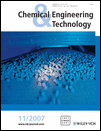Desorption and Biofiltration for the Treatment of Residual Organic Gases Evolved in Soil Decontamination Processses
Abstract
In order to analyze the combination of a rotary kiln and a biofilter in soil decontamination processes, a previously characterized soil was artificially contaminated with toluene, ethylbenzene or p-xylene. The desorption peak of the three compounds occurred very quickly at 20 °C, and consequently, the outlet gas flow from the rotary kiln was initially divided into two different flows. One of them was reduced to a 1/9th fraction of the total flow to be treated in an independent biofiltration system specially acclimated to each contaminant. The sharp desorption peak observed for the three compounds at the outlet of the kiln involved a very high inlet concentration fed into the biofilters in a very short period of time (shorter than 3 h). Consequently, the removal efficiency for toluene was lower than 70 %. However, the removal efficiencies for ethylbenzene and xylene were always higher than 65 %.




